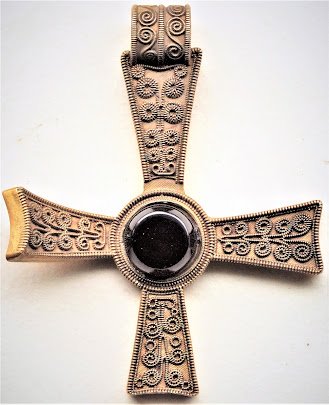Summary. A broken pectoral cross, dated 7th century, was found in the Staffordshire Hoard that must have once belonged to an important early bishop. It is compared to similar crosses associated with Early Medieval bishops. One possibility is it belonged to Chad.
In the Staffordshire Hoard was a pectoral cross[1] suitable for a bishop or abbot to wear on their chest. It had an eyelet at the top and the little wear inside the eyelet suggested a leather thong or silk thread threaded through to hang the cross around a neck. The wearer would then turn it upside down and perhaps kiss it. It would be prominent and an obvious symbol of office.
 |
| Replica of the Staffordshire pectoral cross. |
The cross is similar in size and
shape to the cross of St Cuthbert found in his coffin and now held at Durham
Cathedral. There is a difference between the two regarding the decoration on
the front face. The hoard cross has a pattern of twisted wire filigree in
linked coils in a ‘C’ shape like an eyeglass. ![]()
 |
| Drawing of an intact pectoral cross, contrasted with the Cuthbert cross |
In 1776, a small gold Saxon cross, also with eyeglass filigree, was found in a barrow on Winster Moor[3], Derbyshire. It was missing the middle stone, but the shape and design is very similar to a pectoral cross. It is small being 350 mm long and just under 30 mm wide. If this is a bishop’s pectoral cross, who would have been buried in a barrow on a moor? Bishop Betti is thought to have resided nearby at Wirksworth. A date of 650–700 has been given.
Drawing of the Winster Moor Cross which can be seen in Weston Park
Museum, Sheffield.
Holderness Cross, from Commons Wikimedia, D. Pett, The Portable Antiquities Scheme/The Trustees of the British Museum.
Drawing of the Ixworth Cross, from the Proceedings of the Suffolk Institute of Archaeology, Volume 3, 1863, 296.
Three further crosses include
those found at Wilton, Norfolk (560 mm high), datable to between 613 and 630,
Thurnham, Kent (350 mm diameter) and Milton Regis, Kent, (310 mm diameter).
Smaller crosses attached to necklets have also been found, as well as disc
shaped crosses. There is a distinct similarity in the filigree work on the face
of the cross with two items found in an archaeological excavation at Bamburgh
Castle, Northumberland. The Hunterston brooch (c700) also has this feature.
A pectoral cross found not far
from Lichfield and dateable to the 7th-century could have belonged to any of
four bishops from Chad to Headda. All had an association with Lindisfarne so it
is not surprising for anyone of them to have had a similar sign of office as
worn by Cuthbert. If you accept the Staffordshire Hoard was buried much later,
such as in the 9th century[6]
then many more known clergy can be invoked, including an archbishop.
[1]
Tag: Staffordshire Hoard, Pectoral Cross. The top arm was broken off and
another one bent before it was buried, possibly as a deliberate act to damage a
faith object. A pectoral cross was mentioned in connection with Pope Hilarius
in 461, so wearing such a pendant has a long history.
[2] Four garnets around the centre symbolising the
apostles and twelve along each arm denoting the disciples.
[3] Winster is by the river Derwent which flows into the
Trent south of Derby. It is approximately 40 miles (65 km) from Lichfield.
[4] Holderness is north of the Humber, but not too far
from the mouth of the river Trent. It is approximately 125 miles (200 km) from
Lichfield.
[5]
A. MacGregor, ‘A seventh-century pectoral cross from Holderness, East Yorkshire.’ Medieval
Archaeology (2000), 44, 217-222.
[6]
R. F. Sharp, The hoard and its history. Staffordshire’s secrets revealed, (Studley:
2016) Chapter 7.



